

James Covell has translated an old Japanese children's picture book from 1989, which, back in the day, showed kids how Nintendo games were made, from start to finish. These particular scans show some fantastic pictures of Miyamoto and his team at Nintendo(including Koji Kondo recording the score) putting together the old school classic, Super Mario Bros. 3.
He writes,The book was published in late 1989, based on a tour and interview session at Nintendo of Japan in July of that same year (this will become evident in a later picture). They interview Shigeru Miyamoto, Koji Kondo, all the major players in Nintendo’s games.
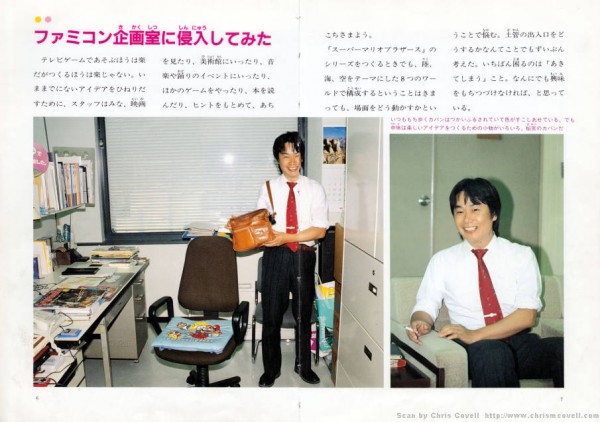 Pictured is the bag that Mr. Miyamoto always carries with him when he goes walking. He’s used it so much that the color has faded. But inside the bag are many little items that he says will aid him in thinking up fun ideas. What’s in the bag is a secret to everyone.
Pictured is the bag that Mr. Miyamoto always carries with him when he goes walking. He’s used it so much that the color has faded. But inside the bag are many little items that he says will aid him in thinking up fun ideas. What’s in the bag is a secret to everyone.
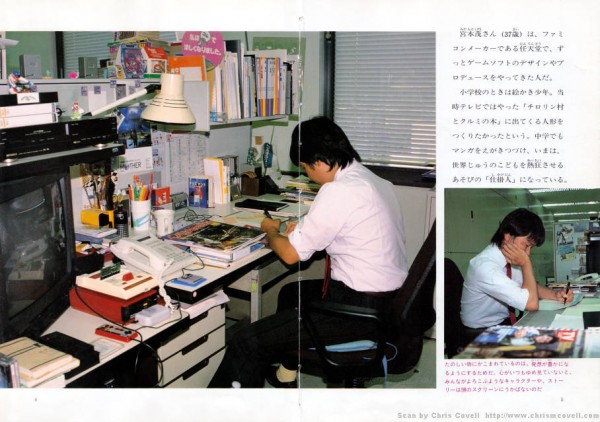 Shigeru Miyamoto (37 years old) has spent his whole career at (Famicom maker) Nintendo designing and producing games.
As a child he loved drawing. He says that he had wanted to design a puppet like those that appeared at that time on the TV show "Chirolin Village and the Walnut Tree". Since starting drawing comics in junior high school, he has now become what he calls the originator of games that thrill children the world over.
Shigeru Miyamoto (37 years old) has spent his whole career at (Famicom maker) Nintendo designing and producing games.
As a child he loved drawing. He says that he had wanted to design a puppet like those that appeared at that time on the TV show "Chirolin Village and the Walnut Tree". Since starting drawing comics in junior high school, he has now become what he calls the originator of games that thrill children the world over.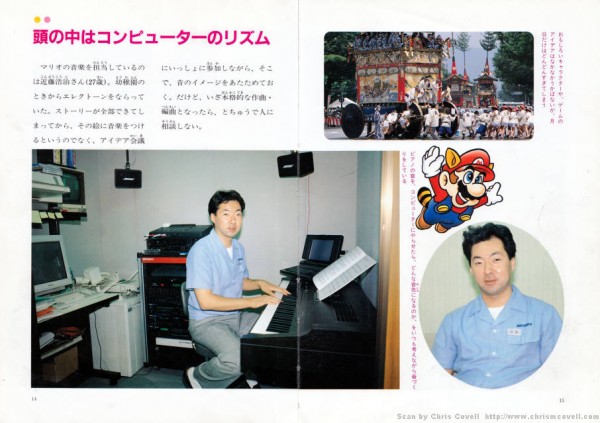 Taking charge of Mario’s music is Koji Kondo (27 years old). He began his studies on the electric organ when he was in kindergarten. He doesn’t begin composing for a game after the story and images have all been completed, but rather he joins in the same brainstorming meetings as everyone else and imagines the sound of the game from these sessions. However, once Kondo has begun full-scale composition and arrangement, he doesn’t consult anybody.
Even when no interesting characters or good game ideas appear, days and months still pass by quickly.
Taking charge of Mario’s music is Koji Kondo (27 years old). He began his studies on the electric organ when he was in kindergarten. He doesn’t begin composing for a game after the story and images have all been completed, but rather he joins in the same brainstorming meetings as everyone else and imagines the sound of the game from these sessions. However, once Kondo has begun full-scale composition and arrangement, he doesn’t consult anybody.
Even when no interesting characters or good game ideas appear, days and months still pass by quickly.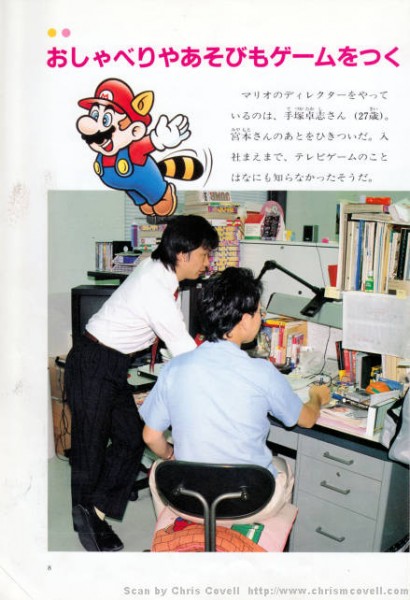 Both chatting and playing are vital to making games.
The man acting as director of the Mario games is Takashi Tezuka (27 years old). He was pulled into this type of work by Mr. Miyamoto. Before entering the company Tezuka says that he knew nothing at all about video games.
Both chatting and playing are vital to making games.
The man acting as director of the Mario games is Takashi Tezuka (27 years old). He was pulled into this type of work by Mr. Miyamoto. Before entering the company Tezuka says that he knew nothing at all about video games.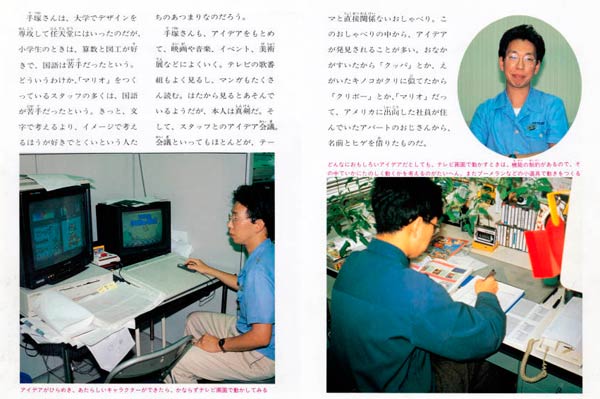 Mr. Tezuka majored in design at university before starting at Nintendo. As a child, he liked arithmetic and drafting, but says he was poor at languages. In fact, many on the Mario team say they were poor at languages. Indeed, many people who think in images rather than words were assembled (on purpose?) for this team.
Tezuka also often looks to movies, music, events, art exhibitions, etc. for ideas. He often watches music shows on TV and reads lots of comic books. While to some this might look like play, it is serious work to him. After this, he conducts a brainstorming meeting with the staff. It might be called a meeting, but most of the time is spent chatting about things not directly related to the theme. In many cases, fresh ideas are discovered out of these chats. For example, he got the name "Koopa" from once when he was hungry (an onomatopoeic sound); and a mushroom he drew resembled more of a chestnut, so he named it "Kuribo" ("Goomba" in the west.) Even the name "Mario" and the idea for his moustache were borrowed from a man living in the same apartment as a Nintendo employee in the United States.
Mr. Tezuka majored in design at university before starting at Nintendo. As a child, he liked arithmetic and drafting, but says he was poor at languages. In fact, many on the Mario team say they were poor at languages. Indeed, many people who think in images rather than words were assembled (on purpose?) for this team.
Tezuka also often looks to movies, music, events, art exhibitions, etc. for ideas. He often watches music shows on TV and reads lots of comic books. While to some this might look like play, it is serious work to him. After this, he conducts a brainstorming meeting with the staff. It might be called a meeting, but most of the time is spent chatting about things not directly related to the theme. In many cases, fresh ideas are discovered out of these chats. For example, he got the name "Koopa" from once when he was hungry (an onomatopoeic sound); and a mushroom he drew resembled more of a chestnut, so he named it "Kuribo" ("Goomba" in the west.) Even the name "Mario" and the idea for his moustache were borrowed from a man living in the same apartment as a Nintendo employee in the United States.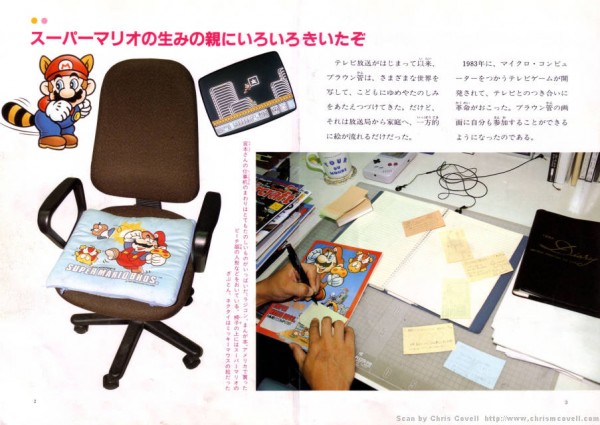 We asked the creators all about the birth of Super Mario.
After the start of television broadcasting, the cathode-ray tube has continued to bring various worlds to people, and dreams and happiness to children. However, these images flowed only one way — from the television station to the home.
We asked the creators all about the birth of Super Mario.
After the start of television broadcasting, the cathode-ray tube has continued to bring various worlds to people, and dreams and happiness to children. However, these images flowed only one way — from the television station to the home.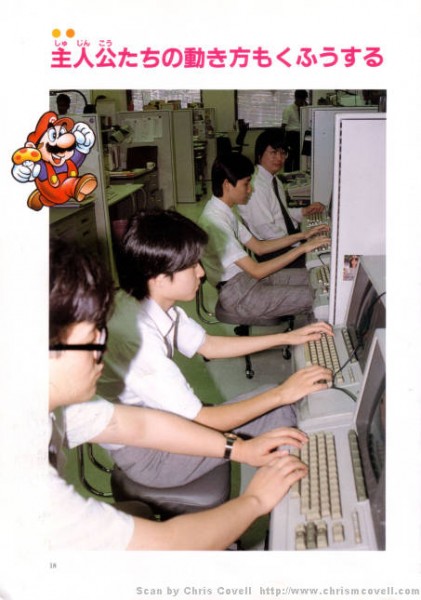 Planning out how our heroes will move
To make anything move on a computer, it is necessary to express it numerically through programming. It takes many hours of serious work.
Planning out how our heroes will move
To make anything move on a computer, it is necessary to express it numerically through programming. It takes many hours of serious work.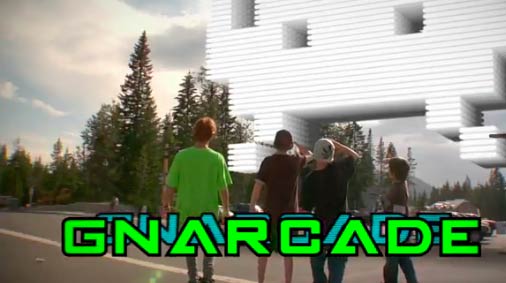 Planning out how our heroes will move
Game Machine Manufacturing Process
Game system components are brought to Nintendo's headquarters in Kyoto from affiliated assembly plants all over the country. Since game systems are computers containing high-density and highly-integrated ICs and LSIs, even a single speck of dust can cause a malfunction.
Planning out how our heroes will move
Game Machine Manufacturing Process
Game system components are brought to Nintendo's headquarters in Kyoto from affiliated assembly plants all over the country. Since game systems are computers containing high-density and highly-integrated ICs and LSIs, even a single speck of dust can cause a malfunction. The hand that guides changes in the project
One year passes quickly for a producer.
The hand that guides changes in the project
One year passes quickly for a producer.

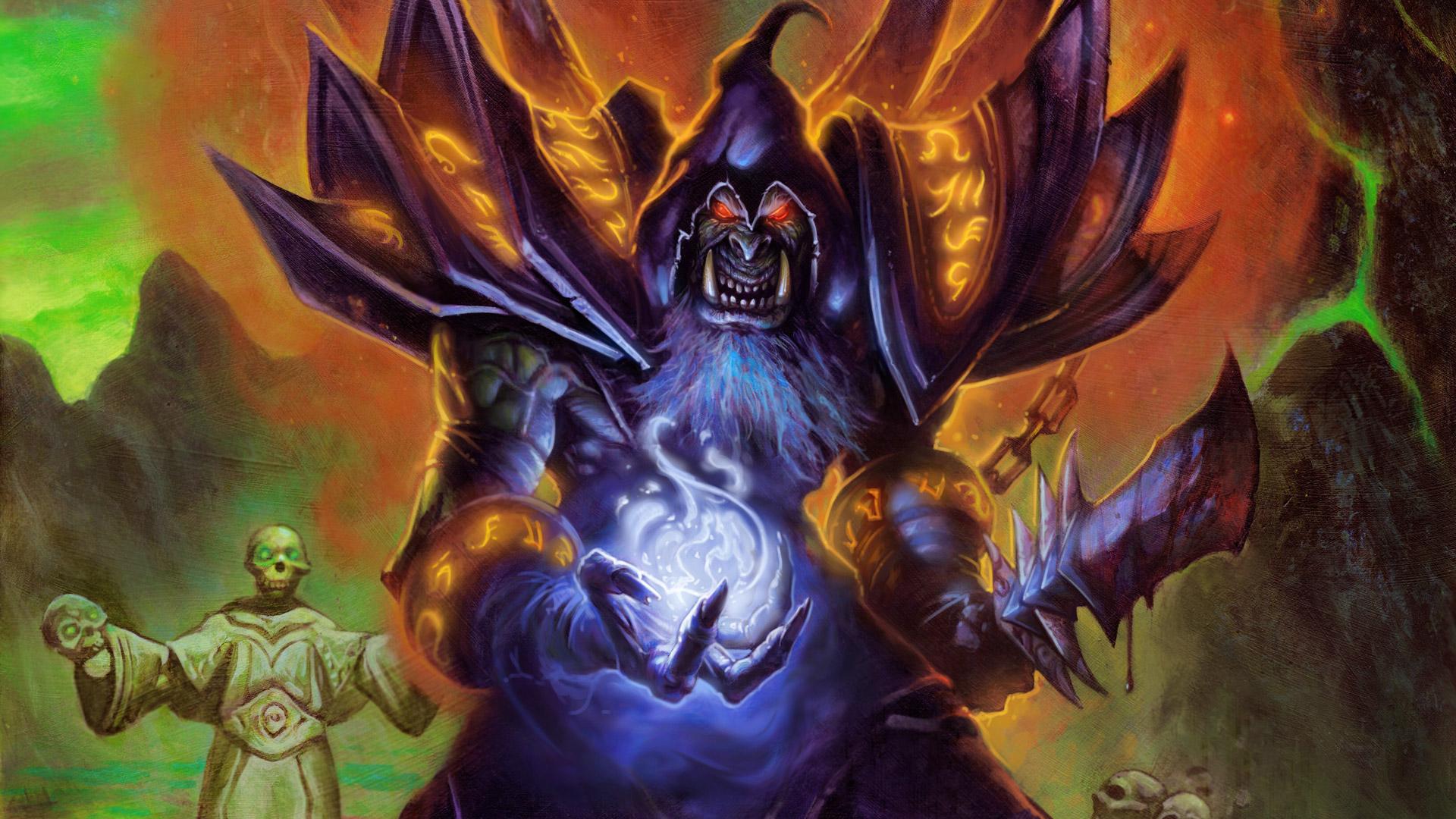
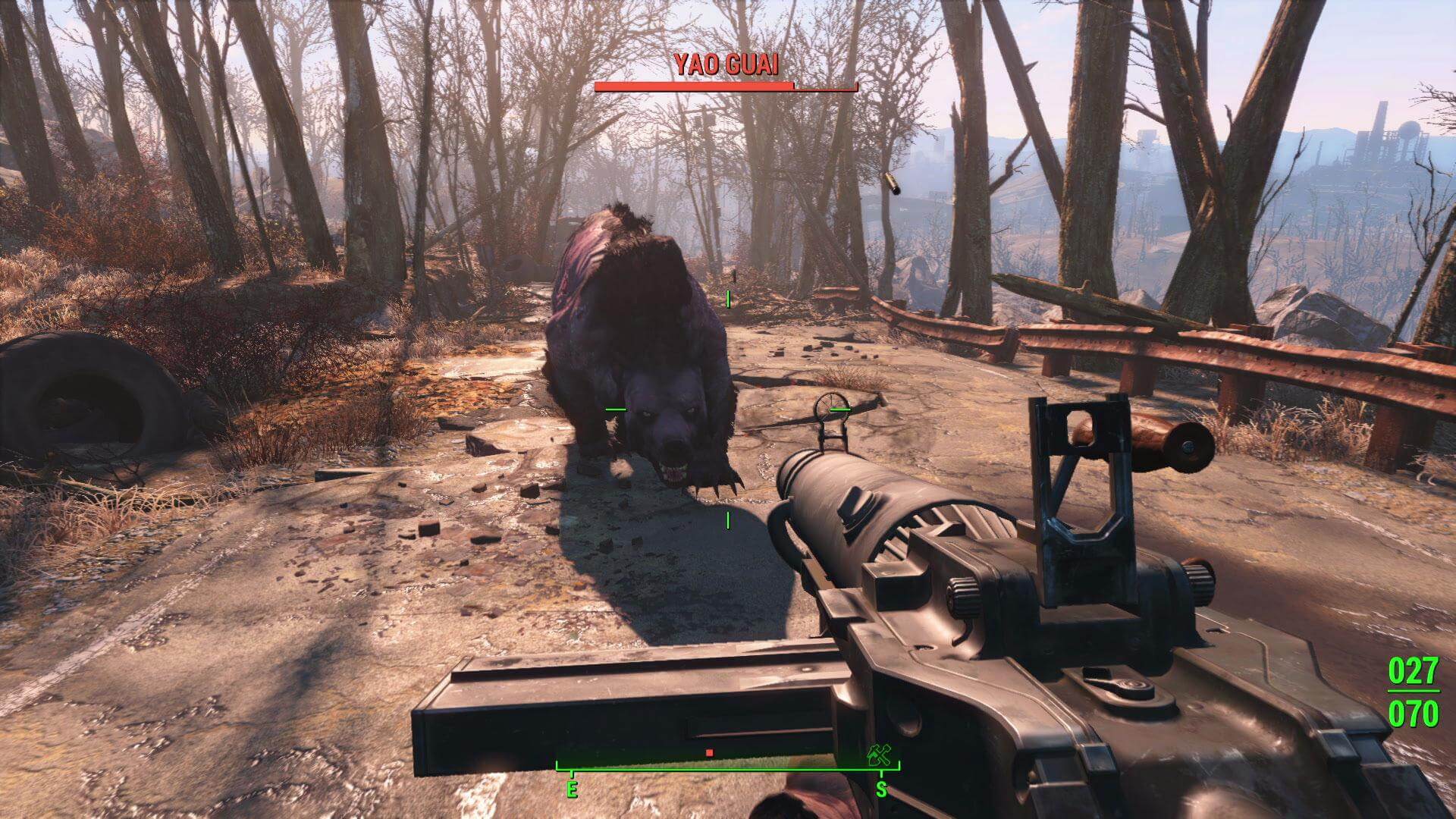
 How to get Achievements for KickBeat Special Edition releasing on PS4, Xbox One and Nintendo Wii U
How to get Achievements for KickBeat Special Edition releasing on PS4, Xbox One and Nintendo Wii U Five Third Party Franchises Sony and Microsoft Might Want to Court
Five Third Party Franchises Sony and Microsoft Might Want to Court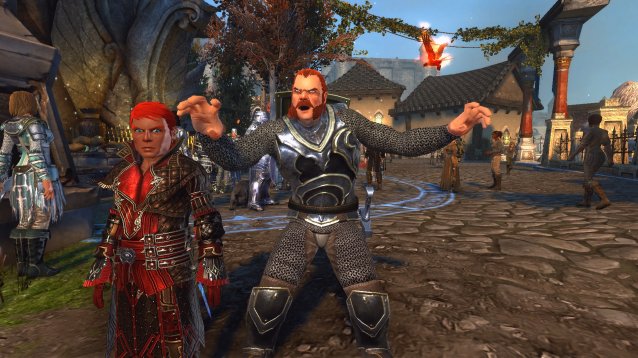 Review: Neverwinter — An MMORPG of a Different Sort
Review: Neverwinter — An MMORPG of a Different Sort Doting Dad Mission GTA 5
Doting Dad Mission GTA 5 Top 5 Best Android Racing Games
Top 5 Best Android Racing Games